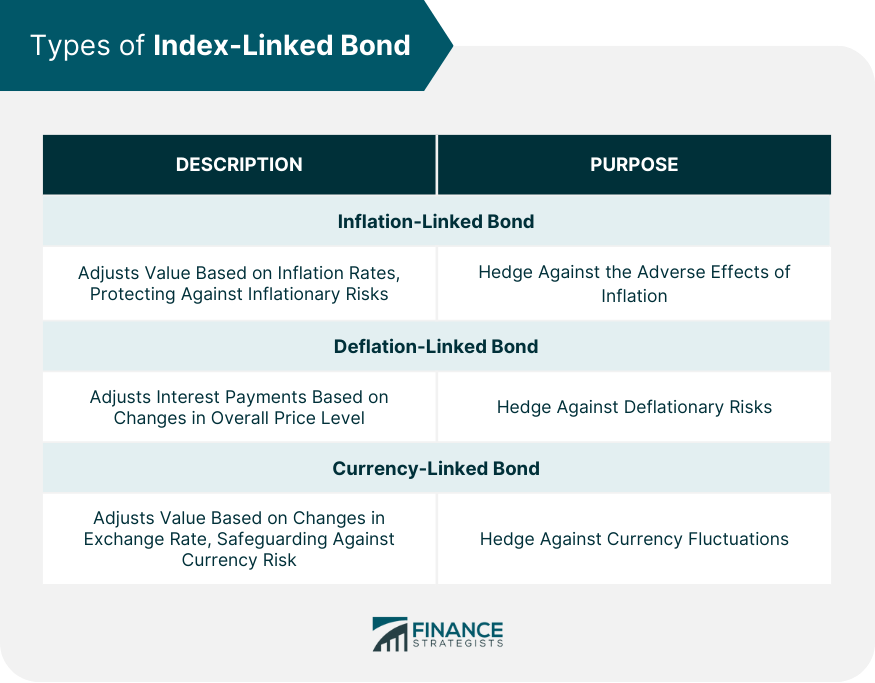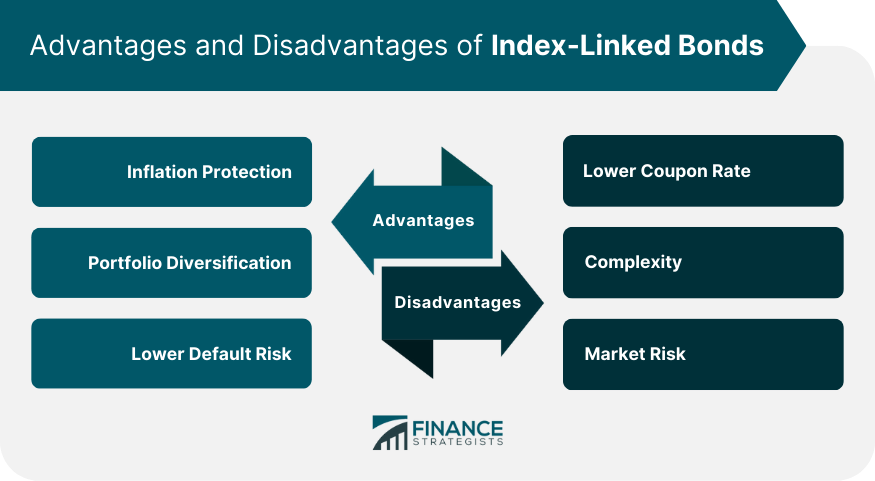An index-linked bond is a type of fixed-income security whose coupon payments and principal repayments are adjusted based on a specified index. This adjustment aims to protect the bondholder from inflation or other market risks. The bond's value is linked to the underlying index, which can be inflation, deflation, or currency rates. Index-linked bonds play a crucial role in the financial market by providing investors with an investment option that has built-in protection against inflation or other market risks. These bonds offer a relatively safe investment alternative, especially during periods of economic uncertainty, when traditional bonds might lose value due to inflation or currency fluctuations. Additionally, index-linked bonds can help governments and corporations raise capital at a lower cost by offering a more attractive investment to potential bondholders. The coupon payment of an index-linked bond is the periodic interest paid to bondholders. Unlike traditional bonds, which pay a fixed interest rate, the coupon payment of an index-linked bond is adjusted based on the underlying index. This adjustment provides bondholders with protection against inflation or other market risks, as the interest payments they receive will increase or decrease in line with the index. Maturity refers to the date when the bond's principal amount becomes due and payable to the bondholder. Like traditional bonds, index-linked bonds have a predetermined maturity date, which can range from a few months to several decades. The maturity date is an essential characteristic of index-linked bonds, as it determines the length of time investors will receive coupon payments and the date when they will receive their principal back. The principal payment is the amount of money the bond issuer must repay to the bondholder upon the bond's maturity. For index-linked bonds, the principal payment is adjusted based on the underlying index to provide protection against inflation or other market risks. This means that the bondholder will receive a principal repayment that reflects the changes in the index over the life of the bond, providing additional security for their investment. The indexation method is the process by which the coupon payments and principal repayments of an index-linked bond are adjusted based on the underlying index. There are various indexation methods, such as daily or monthly adjustments, depending on the specific terms of the bond. The indexation method is essential because it determines how the bond's value will change over time in response to fluctuations in the underlying index. An inflation-linked bond is a type of index-linked bond whose value is adjusted based on inflation rates. These bonds are designed to protect investors from the adverse effects of inflation on their investment. When inflation rates rise, the coupon payments and principal repayments of an inflation-linked bond will increase accordingly, providing investors with a hedge against inflation. A deflation-linked bond is a type of financial instrument designed to protect investors against deflationary risks. Unlike traditional bonds, whose interest payments are fixed, deflation-linked bonds adjust their interest payments based on changes in the overall price level. If there is deflation, the bond's principal and interest payments decrease, providing a hedge against falling prices. These bonds are attractive to investors seeking protection during periods of deflationary pressures. Tied to the exchange rate of a specific currency, a currency-linked bond is an index-linked bond that adjusts its value based on changes in the exchange rate, aiming to safeguard investors from currency risk. As the value of the linked currency rises or falls, the coupon payments and principal repayments of the bond will adapt correspondingly, offering investors a hedge against currency fluctuations. By adjusting coupon payments and principal repayments based on an inflation index, these bonds help ensure that the real value of an investor's investment remains constant, even in times of rising inflation. This protection makes index-linked bonds an attractive investment option for individuals looking to preserve their purchasing power over time. Investing in index-linked bonds can also help investors diversify their portfolios by adding a different type of fixed-income security. This diversification can help reduce the overall risk of a portfolio by spreading investments across various asset classes and investment types. Since index-linked bonds have unique characteristics, they can provide different risk and return profiles compared to traditional bonds, further enhancing portfolio diversification. Index-linked bonds generally have a lower risk of default than traditional bonds. This is because the issuers of index-linked bonds are typically governments and large corporations with strong credit ratings. Furthermore, the built-in protection against inflation or other market risks makes these bonds more attractive to investors, reducing the issuer's cost of borrowing and decreasing the likelihood of default. One disadvantage of index-linked bonds is that they tend to offer lower coupon rates than traditional fixed-rate bonds. This is because the built-in inflation protection makes these bonds less risky for investors, resulting in lower required returns. However, the lower coupon rate may not always be a disadvantage, as the overall return on investment can be higher for index-linked bonds when factoring in the adjustments for inflation or other market risks. Index-linked bonds can be more complex than traditional bonds due to their unique characteristics and adjustments based on underlying indices. Investors may need to spend additional time and effort to understand the specific terms, indexation methods, and potential risks associated with index-linked bonds. This complexity can be a barrier to entry for some investors, particularly those with limited financial knowledge or experience. While index-linked bonds provide protection against specific market risks, such as inflation or currency fluctuations, they are not immune to other market risks. For example, interest rate changes can still affect the value of index-linked bonds, as they do with traditional bonds. Additionally, the performance of the underlying index can be unpredictable, and unforeseen events may cause the index to move in unexpected ways, impacting the bond's value. Index-linked bonds are fixed-income securities that offer built-in protection against inflation or other market risks by adjusting coupon payments and principal repayments based on a specified index. These bonds come with various characteristics, such as maturity, coupon payment, principal payment, and indexation method, and can be classified into different types, such as inflation-linked, deflation-linked, and currency-linked bonds. Investing in index-linked bonds offers several advantages, including inflation protection, portfolio diversification, and lower default risk. However, they also come with disadvantages, such as lower coupon rates, complexity, and exposure to market risks. It is essential for investors to carefully consider the advantages and disadvantages of index-linked bonds before adding them to their portfolios, taking into account their investment goals, risk tolerance, and investment horizon.Definition of Index-Linked Bond
Characteristics of Index-Linked Bond
Coupon Payment
Maturity
Principal Payment
Indexation Method
Types of Index-Linked Bond
Inflation-Linked Bond
Deflation-Linked Bond
Currency-Linked Bond

Advantages of Index-Linked Bond
Inflation Protection
Portfolio Diversification
Lower Default Risk
Disadvantages of Index-Linked Bond
Lower Coupon Rate
Complexity
Market Risk

The Bottom Line
Index-Linked Bond FAQs
Index-linked bond is a type of bond that pays a return linked to a particular index, such as inflation, deflation, or currency.
Index-linked bonds protect against inflation by adjusting the principal or coupon payment according to the inflation rate.
Index-linked bonds provide inflation protection, portfolio diversification, and lower default risk compared to traditional bonds.
The risks of investing in index-linked bonds include lower coupon rates, complexity, and market risk.
Inflation-linked bonds pay a return linked to inflation, whereas deflation-linked bonds pay a return linked to deflation. Inflation-linked bonds protect against inflation, while deflation-linked bonds provide protection against deflation.
True Tamplin is a published author, public speaker, CEO of UpDigital, and founder of Finance Strategists.
True is a Certified Educator in Personal Finance (CEPF®), author of The Handy Financial Ratios Guide, a member of the Society for Advancing Business Editing and Writing, contributes to his financial education site, Finance Strategists, and has spoken to various financial communities such as the CFA Institute, as well as university students like his Alma mater, Biola University, where he received a bachelor of science in business and data analytics.
To learn more about True, visit his personal website or view his author profiles on Amazon, Nasdaq and Forbes.











